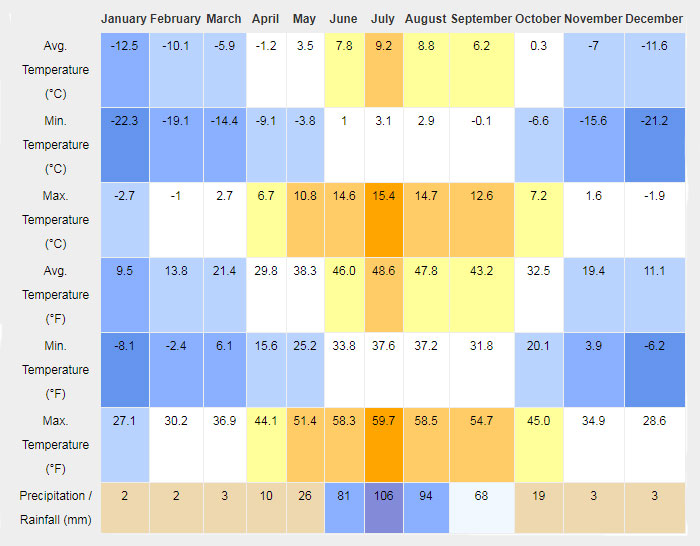
Nagqu Climate
Nagqu Weather & Climate describes information with temperature & precipitation. Find out the best time to visit Nagqu and see the season highlights in Nagqu Tibet. It also tells you what to wear in different seasons and clothes packing for your trip to Nagqu Tibet.
Nagqu Climate and Weather
Nagqu belongs to the sub-frigid zone, with extremes of cold and wind, is an area prone to extremely dry air and violent storms. Throughout the year, there is no period where there is no frost in Nagqu, and the land is under a state of semi-permanent permafrost, even in the summer months. The average temperature for the year in Nagqu is 30.0°F (-1.1°C). The warmest month, on average, is July with an average temperature of 48.0°F (8.9°C). The coolest month on average is January, with an average temperature of 8.0°F (-13.3°C).
Nagqu is affected by monsoon climate, plate geology movements, and complex terrain and other disaster-causing factors, it is a natural disaster-prone, contiguous and frequent region. The annual average temperature is −2.1 °C (28.2 °F), while the coldest temperatures can reach minus −40 °C. The annual sunshine hours are more than 2,886 hours. It is relatively warm from May to September in the middle of the year, and from November to March there is a dry windy period. Nagqu had an average annual rainfall of 477.1 mm (18.78 in) between 1956 and 2010. The southeastern part of the prefecture is wetter, with annual precipitation exceeding 580 mm. while the northwestern part is driest with an average annual rainfall below 440 mm. The effects of global warming increasingly pose a problem in the region, with record highs in 2019.
Nagqu Weather and Climate Graph

In Nagqu, the dry season and wet season are very obvious. The dry season is from November to March of next year with dry and arid air. Even the daytime temperatures in the dry season are low, with highs of around -3°C during the day in January, and staying below freezing until around mid-March.
Nagqu Weather and Climate by Month
Four Seasons of Nagqu and What to Pack
- Spring: The average temperature of the spring in Nagqu is -14°C ~ 3°C. The average daytime temperature is 3°C and it is recommended to wear windbreaker, sweater, wool suits and other warm clothes. The average night temperature is -14°C and it is recommended to wear cotton coat, winter coat, leather jacket, thick coat, hat, gloves, down jacket, leather coat and other heavy warm clothes.
- Summer: The average temperature of the summer in Nagqu is 4°C-16°C. The average daytime temperature is 16°C and it is recommended to wear warm clothes such as suits, jacket, windbreaker, casual wear and thin sweater. The average night temperature is 4°C and it is recommended to wear windbreaker, coat, sweater, winter clothes and other warm clothes.
- Autumn: The average temperature of the autumn in Nagqu is -15°C ~ 2°C. The average daytime temperature is 2°C and it is recommended to wear windbreaker, coat, sweater, wool suit, winter clothes and other warm clothes. The average nighttime temperature is -15 °C and it is recommended to wear thick warm clothes such as cotton coat, winter coat, leather jacket, thick coat, hat, gloves, down jacket and fur coat.
- Winter: The average temperature of the winter in Nagqu is -19°C ~-1°C. The average temperature during the day is -1°C and it is recommended to wear thick warm clothes such as cotton coat, winter coat, leather jacket, thick coat, hat, gloves, down jacket and leather jacket. The average nighttime temperature is -19°C and it is recommended to wear thick warm clothes such as cotton coat, winter coat, leather jacket, thick coat, hat, gloves, down jacket, and fur coat.
Note: Due to the severe sunlight on the plateau and wide temperature division between day and night, you are highly advised to carry sunglasses, sun cap, sun blocking cream, lip cream, Aspirin, medicine for cold and digestion, etc.
Best Time to Visit Nagqu
From May to September is the best time to visit Nagqu. Nagqu is sub-arctic climate zone, cold and oxygen deficit. The climate is dry, windy, with the annual average temperature of -0.9 ℃ to -3.3 ℃. Every year from November to March is arid windy period, dry climate, low temperature, hypoxia wind, long duration. May to September is relatively warm. It is the best time to visit Nagqu.
Travel Tips for Visiting Nagqu
- Do not plan your Nagqu Tour in the peak holidays. Because they are popular in Chinese tourists, Nagqu attractions become more crowded in these periods. The most crowded seasons in China are Chinese Spring Festival (usually in late Jan. or early Feb.), International Labor Day (May 01 to 03) and National Day (Oct. 01-07). Spring Festival and the National Day golden week are the most crowded time for travelling.
- Be careful of the changeable temperature. A few chilly days could be followed by relatively hot weather. So it is better to take some early winter clothes to protect you away from the sudden low temperature.
- The average altitude of Nagqu is around 3,500-4,500 meters. You may suffer slightly from high altitude sickness in the first two days, but don't worry you can acclimatize yourself gradually by going for some leisure walking instead of strenuous activity after arrival. You'd better not have bath, in case of catching a cold. Drinking more water and having some fruit will be helpful.
Keep Reading













